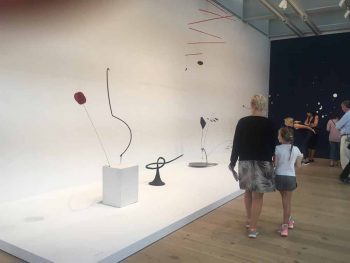By Lele Galer, Columnist, The Times
 The Art Watch column is written to describe art events and artists working in the Brandywine Region, but this Art Watch moves 2 and a half hours north to New York City’s Whitney Museum of American Art. As most of you know in 2015, the famous Whitney Museum of American Art moved from its iconic Breuer designed minimalist building on Madison Avenue to the Lower West Side, Chelsea area at 99 Gansevoort Street.
The Art Watch column is written to describe art events and artists working in the Brandywine Region, but this Art Watch moves 2 and a half hours north to New York City’s Whitney Museum of American Art. As most of you know in 2015, the famous Whitney Museum of American Art moved from its iconic Breuer designed minimalist building on Madison Avenue to the Lower West Side, Chelsea area at 99 Gansevoort Street.
This is the third move since its opening in 1930, with a mission to house modern and contemporary American art. I have been meaning to get to the new Whitney, but I am not a fan of the congestion and parking problems on the lower West Side, but their highlighted new Alexander Calder exhibit “Calder: Hypermobility” finally got me in the car to New York City’s “meat-packing district” and it was a completely expected and thoroughly enjoyable art experience.
Leaving from Chester County, there are a number of ways to get to the Lower West Side, but we took the Lincoln Tunnel and parked near the wonderful “High Line” which is a 1.45 mile long elevated trail that runs along the river. High Line has multiple entry points from the street and is a brilliant design for a walkway that combines steel industrial chic, with wild gardens, trees, and sculpture along with pop up musicians, food stands and places to sit or lie down. Walking along High Line is a complete pleasure, with gorgeous views of buildings to one side and the river to the other. The new location for the Whitney Museum of American Art is at the very start of High Line, so walking along High Line to the Whitney is a terrific way to get to the museum.
The museum is eight floors, with plenty of elevators and multiple indoor and outdoor stairways to get to the collections. It is a wonderful museum space that is spacious and light filled. The extraordinary views of the city are so compelling that the visitor is as drawn to the interior art exhibitions as to the exterior views from the building. There are multiple external terraces and stairways that float from gallery spaces over and into the city’s panorama.
We started on the eighth floor and worked our way down through the collections. The Calder exhibit “Calder: Hypermobility” is all housed in one large gallery and displays about 30 examples of his interactive sculptures: mobiles, stabiles, motor-driven abstractions, wall pieces, and gongs. Each piece was different from the other and each piece offered something new, exciting and fun. It seemed like everyone in the gallery was smiling. Calder is a very joyful creator and his works are delightful and inviting. It is very difficult to hold yourself back from touching his works, or blowing on them to see them gently twirl. Looking through the exhibition space is a large red Calder mobile that hangs over the Whitney restaurant space; a great place to catch a quick bite to eat, with an excellent wine menu. Sitting down, on one side you see Calder works from floor to ceiling and on the other you see all of lower Manhattan. Pretty cool.
The lower seventh and sixth floors house the Whitney’s permanent collection (which is constantly changing as they move different works in and out of their storage). I was struck by the enormous variety of art in their permanent collection, different mediums, famous and less famous artists, artists of different ethnicities as well as plenty of women artists. This month, the seventh Floor had a large number of artists who worked in the 1930s, which is a great complement to the recent Brandywine River Museum of Art’s show “Rural Modern” and shared some of the same artists, including Charles Sheeler, Georgia O’Keefe, and Charles Demuth. The last galleries on the floor have artists from the late 1950s and 1960s including Ruth Asawa’s gorgeous metal crocheted hanging sculpture “Number 1-1955”, “The Eyes” by Jay DeFeo, Edward Hopper’s “On View” and “Tet” by Morris Louis. Paintings, wood cuts and photography was all displayed side by side in a visually challenging and interesting way. Each piece was a different clear voice.. focusing on the artistically inventive, aesthetically uplifting, politically jarring, the quiet voice or the loud. By the time you leave the 7th floor you feel that you have been on a fascinating journey that poked at your sight, mind, and emotions. I suggest you visit the Whitney with friends so that you can chat together about your responses.
Ready and invigorated to see the sixth Floor, this floor was predominantly “An Incomplete History of Protest: Selections from the Whitney’s Collection, 1940-2017” which was a very interesting and thought-provoking show concerning art that presents a protest to a contemporary issue, whether it be autocratic government, racism, free speech, or women’s rights, each artist is skillfully showcased to present their point of view. The curatorial written descriptions are extremely helpful throughout the museum, as they give a sense of time and place and personality to the art. I found some of the works to be annoying and pretentious, others to be moving and absorbing. Don’t expect to like everything, but you cannot help but be bowled over by the breadth and quality of the works as well as the genius of the museum’s exhibition staff.
If the eighth Floor was a marvel of Calder invention, the seventh Floor an immersion into the canvas of 20th Century America, the sixth Floor a leap into the political, the fifth Floor was something else altogether. The entire 6th Floor is dedicated to “Hélio Oiticica: To Organize Delirium” which offers over a dozen gallery spaces that encourage visitor participation in unique ways. Oiticica is a famous Brazilian artist who worked both in New York and in Brazil in the 1960s-80s. Different galleries reflect his artistic responses to contemporary political issues, and in every case, he created environments that encourage the viewer to look, touch, walk-through, interact with, listen to and play in.
There is a pool table where you can play pool with visitors, a small wading pool, real parrots in cages, a miniature sandy beach and wading pool, a room filled with hammocks surrounded by Jimi Hendrix videos, a contemplation room with comfortable pads to lie on, and a large video room with a music soundtrack and a dozen costumes designed by the artist for viewers to try on and dance in. Each room has well-written descriptions of the artist’s intentions and of the historical and political climate of the time. Each room, in its own way, is quite a lot of fun. Children and adults alike were scrambling to undo their shoes and wander into the mini-beach, sit and chat under a beach tent, and sink their toes into sand while looking out onto a panoramic view of the river. Everyone was having fun, laughing and chatting with strangers. It was quite a thrill, and not at all the stuffy museum-going New York crowd that we might have been expecting.
Back on the street, under the High Line, are hundreds of art galleries as well as shops, including the very entertaining Chelsea Market. The Chelsea Market offers many opportunities for a quick bite to eat without too much damage to your wallet, and it is a terrific experience in and of itself.
It takes about 2 and one half hours to get from Chester County to The Whitney Museum of American Art, and from top to bottom, it offers an exhilarating art experience in sight, sound, touch, thought and emotions. I didn’t see one person that left the Whitney Museum without a broad smile on their face. Going to the Whitney I expected to see wonderful art, but I didn’t expect to have quite so much fun!










